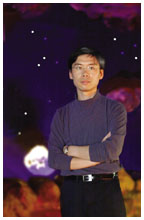|
Web Exclusives: Alumni Spotlight
June 6, 2004: Searching
for the beginning of time Since he was a young boy in China, Xiaohui Fan *00 has been fascinated with the sky. “I just liked looking at stars,” says the assistant professor of astronomy at the University of Arizona. Today he looks at computer screens that relay data from powerful telescopes and digital cameras to see celestial objects. Named one of the top 10 brilliant young minds by Popular Science magazine last year, Fan and his collaborators are searching for the first light after the Big Bang. Fan has discovered very distant quasars 13 billion years old — among the first generation of objects that emerged in the universe. “We’re trying to push even farther back,” says Fan, who earned a Ph.D. in astrophysical sciences. “We know there are things beyond what we can see.” The Big Bang, which occurred about 13.7 billion years ago, was followed by the cosmic dark age. “Nothing obvious was going on in the universe,” which was dark and cold, he explains. The distant quasars he has found appeared very soon after the first stars that ended the dark age. These very old quasars look like red dots on a computer screen because as they move away from the Earth, the wavelengths of the light they emit stretch and appear red. Scientists like Fan can determine the age of a quasar by measuring how much its wavelength is stretched. “Finding quasars is hard,” says Fan, because they are so rare. Fan wrote a computer program in the late 1990s to sift through data from the Sloan Digital Sky Survey for “very, very red objects” that may be very distant quasars. The Sloan Survey, a collaborative effort of 11 institutions including Princeton, is taking color images of one-quarter of the sky using a telescope and a powerful digital camera developed by Princeton Professor of Astronomy James Gunn. The Sloan Survey generates 20 gigabytes of data per hour — enough to fill up the average desktop computer every hour. After identifying possible quasars, Fan next examines them in more detail through larger telescopes like Keck, the world’s largest telescope, in Hawaii. As Fan studies the properties of quasars, he’s also learning about the end of the cosmic dark age — called reionization, when the universe changed from dark to light. To look farther back and see the very first stars, scientists like Fan need a next-generation telescope launched in space that will detect infrared wavelength. That telescope, the James Webb Space Telescope, is on the drawing board. NASA plans to launch it within about 10 years, says Fan. When Fan takes breaks from looking at computer screens inside
the control rooms of observatories perched atop mountains, he goes
outside to check the weather. “That is the time I really enjoy,”
he says. Looking up, he says, “just the sheer beauty of the
sky at that time overwhelms you.” By K.F.G.
|
||

